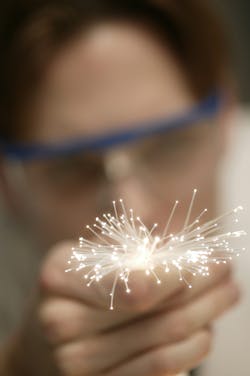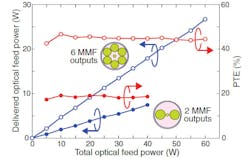In the latest attempt to confront the growing power demands of wireless communications, a research team from the University of Electro-Communications in Japan has invented a fiber optic system that transmits both data and power over the same cable.
The research team, led by Motoharu Matsuura, has shown that the new system is capable of sending up to 60 watts over a distance of 300 meters. The researchers suggest that the fiber optic cable would be ideal for the growing infrastructure behind small cells—low-power, short-range radio terminals that backhaul data from the edge of a wireless network.
In recent years, fiber optic power cables have been the subject of quiet but hard-nosed research, but most systems developed so far transmit little power. In 2012, scientists from Sandia National Laboratories in New Mexico invented one of the earliest power-over-fiber systems, using laser diodes on one end of the cable and a miniature photovoltaic cell on the other end. However, the scientists acknowledged the system’s limitations, saying that it could only power the fiber’s internal electronics. At the time, the researchers were also adding the capability to send power externally into low-power sensors and control systems.
Last year, Matsuura and his research set out to design a system that could effectively supplement the main power delivered to small cells. As described in research published last June, the research team bundled two multimode power fibers with one multimode data fiber, fusing them into a single double-clad cable at one end. The double-clad cable, which consists of an inner core surrounded by two outer layers of optical fiber, helps to prevent crosstalk.
The team linked the cable to a central data station and a radio antenna. A laser diode created test signals to IEEE 802.11g specifications, while separate laser diodes supplied the optical power. When an amplified optical signal traveled through the cable, however, most of the power escaped as heat. Although the power output reached 40W in this initial experiment, the power efficiency was only 20%.
After these early experiments, Matsuura's research team discovered that the power efficiency was being limited by the cross-sectional area of the fibers. When bundled together, the two multimode fibers left empty space in the cable, so that their combined area was less than the area of the fused cable further down the line. The result, Matsuura said, was a very inefficient power transfer.
In the research published earlier this month, the team adjusted their design. As described in the journal Optics Letters, they narrowed the power-carrying fibers and increased their number to six. This helped to optimize the cross-sectional area without introducing other limitations that additional fibers might have caused.
The other benefit of the power-over-fiber system is that it protects the antenna units from unexpected breaks in the main power supply, such as a lighting strike or power surge. The point is "to maintain total electrical isolation from any stray electrical energy," says Steve Sanderson of Sandia National Laboratories.
However, optical fibers that send more power over longer distances will be required to alleviate some of the problems with small cell infrastructure. Peadar Forbes, product marketing manager for integrated transceivers at Analog Devices, says one of the problems with deploying small cells is the logistics of connecting them to a power source and fiber optic cable. While he understands the thought behind the research, he adds that a power-over-fiber cable is not a "silver bullet" for this problem.
Small cells located indoors, which typically consume between 13 and 50W depending on their capacity, already use a system that transmits power and data over the same cable: power-over-Ethernet. Because power-over-Ethernet is the de facto standard for indoor models, the power-over-fiber cable would only be suited for outdoor small cells, which Forbes says consume between 50 and 350W. Forbes adds that small cells typically have to haul data over longer distances than the 300 meter range of the new cable.
About the Author
James Morra
Senior Editor
James Morra is the senior editor for Electronic Design, covering the semiconductor industry and new technology trends, with a focus on power electronics and power management. He also reports on the business behind electrical engineering, including the electronics supply chain. He joined Electronic Design in 2015 and is based in Chicago, Illinois.


